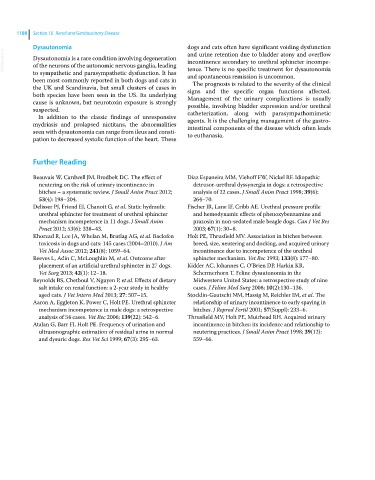Page 1250 - Clinical Small Animal Internal Medicine
P. 1250
1188 Section 10 Renal and Genitourinary Disease
Dysautonomia dogs and cats often have significant voiding dysfunction
VetBooks.ir Dysautonomia is a rare condition involving degeneration and urine retention due to bladder atony and overflow
incontinence secondary to urethral sphincter incompe
of the neurons of the autonomic nervous ganglia, leading
to sympathetic and parasympathetic dysfunction. It has tence. There is no specific treatment for dysautonomia
and spontaneous remission is uncommon.
been most commonly reported in both dogs and cats in The prognosis is related to the severity of the clinical
the UK and Scandinavia, but small clusters of cases in signs and the specific organ functions affected.
both species have been seen in the US. Its underlying Management of the urinary complications is usually
cause is unknown, but neurotoxin exposure is strongly possible, involving bladder expression and/or urethral
suspected. catheterization, along with parasympathomimetic
In addition to the classic findings of unresponsive
mydriasis and prolapsed nictitans, the abnormalities agents. It is the challenging management of the gastro
intestinal components of the disease which often leads
seen with dysautonomia can range from ileus and consti to euthanasia.
pation to decreased systolic function of the heart. These
Further Reading
Beauvais W, Cardwell JM, Brodbelt DC. The effect of Diaz Espaneira MM, Viehoff FW, Nickel RF. Idiopathic
neutering on the risk of urinary incontinence in detrusor‐urethral dyssynergia in dogs: a retrospective
bitches – a systematic review. J Small Anim Pract 2012; analysis of 22 cases. J Small Anim Pract 1998; 39(6):
53(4): 198–204. 264–70.
Delisser PJ, Friend EJ, Chanoit G, et al. Static hydraulic Fischer JR, Lane IF, Cribb AE. Urethral pressure profile
urethral sphincter for treatment of urethral sphincter and hemodynamic effects of phenoxybenzamine and
mechanism incompetence in 11 dogs. J Small Anim prazosin in non‐sedated male beagle dogs. Can J Vet Res
Pract 2012; 53(6): 338–43. 2003; 67(1): 30–8.
Khorzad R, Lee JA, Whelan M, Brutlag AG, et al. Baclofen Holt PE, Thrusfield MV. Association in bitches between
toxicosis in dogs and cats: 145 cases (2004–2010). J Am breed, size, neutering and docking, and acquired urinary
Vet Med Assoc 2012; 241(8): 1059–64. incontinence due to incompetence of the urethral
Reeves L, Adin C, McLoughlin M, et al. Outcome after sphincter mechanism. Vet Rec 1993; 133(8): 177–80.
placement of an artificial urethral sphincter in 27 dogs. Kidder AC, Johannes C, O’Brien DP, Harkin KR,
Vet Surg 2013; 42(1): 12–18. Schermerhorn T. Feline dysautonomia in the
Reynolds BS, Chetboul V, Nguyen P, et al. Effects of dietary Midwestern United States: a retrospective study of nine
salt intake on renal function: a 2‐year study in healthy cases. J Feline Med Surg 2008; 10(2):130–136.
aged cats. J Vet Intern Med 2013; 27: 507–15. Stocklin‐Gautschi NM, Hassig M, Reichler IM, et al. The
Aaron A, Eggleton K, Power C, Holt PE. Urethral sphincter relationship of urinary incontinence to early spaying in
mechanism incompetence in male dogs: a retrospective bitches. J Reprod Fertil 2001; 57(Suppl): 233–6.
analysis of 54 cases. Vet Rec 2006; 139(22): 542–6. Thrusfield MV, Holt PE, Muirhead RH. Acquired urinary
Atalan G, Barr FJ, Holt PE. Frequency of urination and incontinence in bitches: its incidence and relationship to
ultrasonographic estimation of residual urine in normal neutering practices. J Small Anim Pract 1998; 39(12):
and dysuric dogs. Res Vet Sci 1999; 67(3): 295–63. 559–66.

